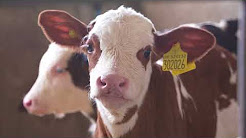The Calf to Calving video features Aberdeen-based dairy farmers William and Anne Willis, who took part in the project which ran for two years on twelve farms across Britain. The C2C programme followed groups of ten calves from birth to first calving, with the aim of getting them to calve at 24 months.
Consultant Andy Dodd, who spearheaded AHDB’s programme, says: “Working with farmers over the course of this project we soon developed an understanding of the key areas they needed to focus on to succeed in calving at 24 months, something which is better for the heifer, as well as improving the bottom-line significantly.”
In the video Andy shares the team’s six top tips for farmers looking to improve their management of young stock which include developing targets and understanding your costs as well as providing high quality colostrum tested using a refractometer.
“We also recommend developing robust protocols for calf management so they always get the same standard of care no matter who is looking after them,” Andy says, “and of course regular weighing is incredibly important for monitoring growth rates.
“Really, it all comes down to attention to detail, and throughout the project we’ve seen that having that really does pay off.”
Host farmer Anne admits that before the Calf to Calving programme calves were a ‘forgotten extra’ on farm, but all that has changed.
She says: “Our aim now is to lose nothing as soon as it enters the calf shed. We now have a protocol in place so we all know exactly what happens in the calf shed, how much colostrum has been given, everything. That protocol is paramount.”
Anne’s son William believes the biggest changes have been related to colostrum management and weighing of young stock.
“We weren’t regularly weighing prior to the programme but we now appreciate how important that is,” he says, “so we can set our ration up at the start of winter and then we assess what growth rates we are getting and then fine tune that.
“We’ve found that if you can get the heifers on weight and on target in the first year then everything else follows on.
Another local farmer, Bruce Mackie, who attended the meetings at Glasgoforest farm has also seen big changes on his farm thanks to the programme. As well as a greater appreciation of regular weighing, Bruce made significant changes to his calf housing, installing a new ventilation system and adding two calf pens to reduce group sizes and have a clean pen available when required.
“The new positive pressure ventilation system and pens have really improved the environment for the calves, and it’s been such a success we saw mortality drop almost instantly in the herd, and we’re really pleased to report that in the last four months we haven’t had a single death within our youngstock.”
While the programme has come to an end, AHDB will continue to communicate the top tips through the strategic dairy farm initiative which uses farmer-to-farmer learning to accelerate the uptake of technical and business information.
As Anne says: “Throughout the project everyone was prepared to openly discuss and share their experiences; farmer-to-farmer learning really is the best way of sharing knowledge.”




